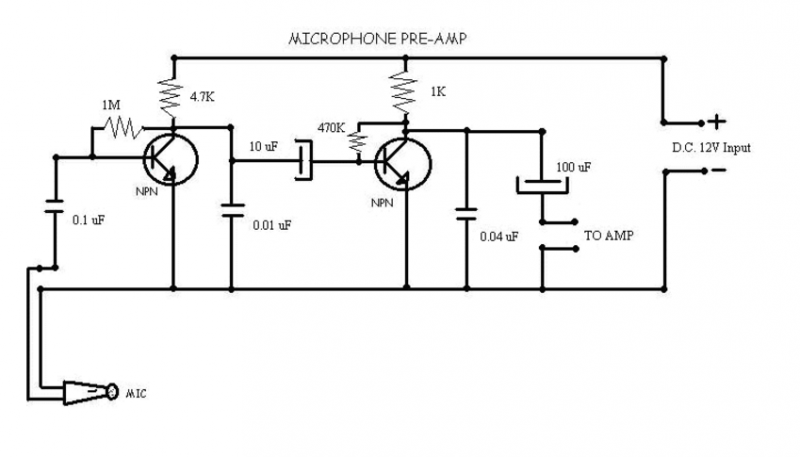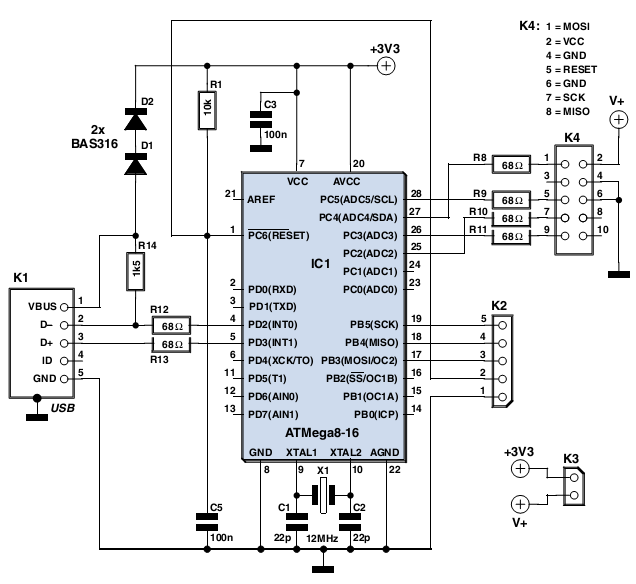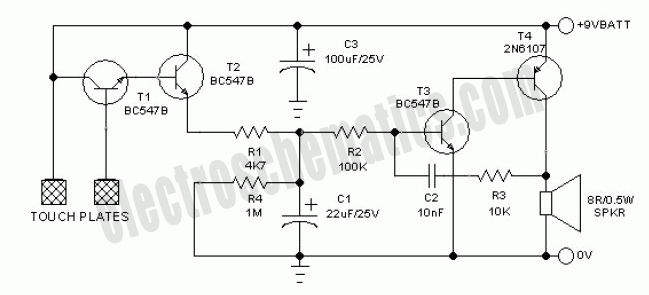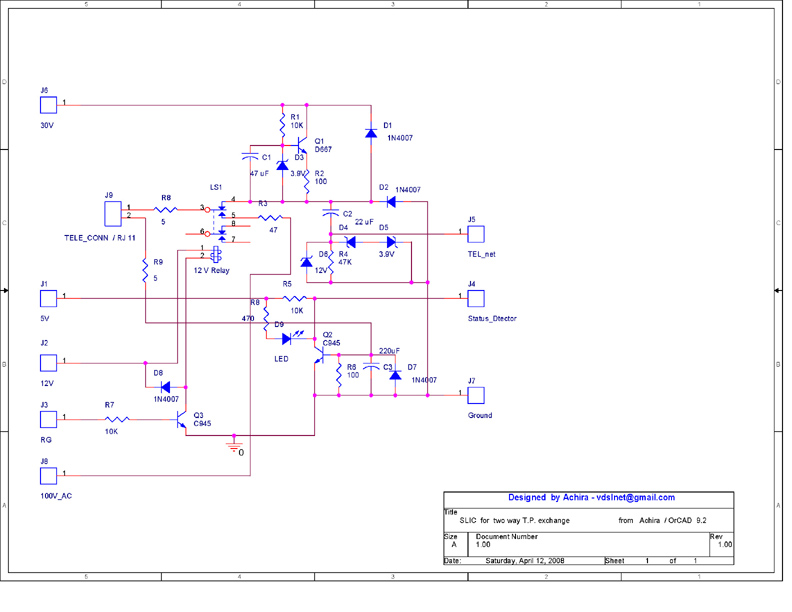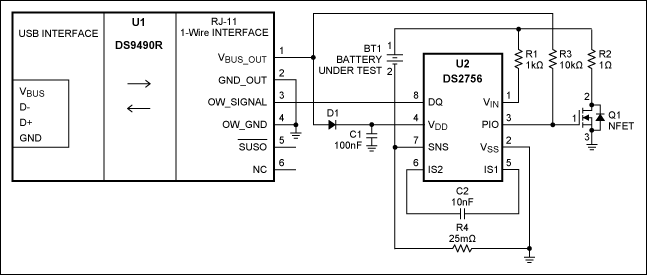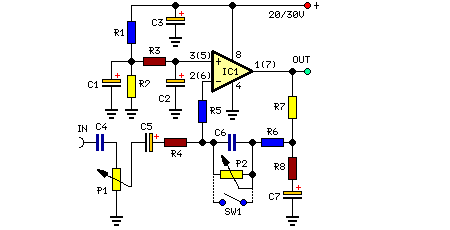
Simple Microphone Preamplifier Project
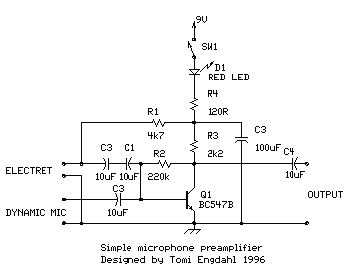
This is a simple microphone preamplifier circuit designed for use between a microphone and a stereo amplifier. This circuit is compatible with standard home stereo amplifier line, CD, aux, and tape inputs. It can accept both dynamic and electret microphone inputs, with the preamplifier providing power for electret microphone elements. The design prioritizes simplicity to facilitate easy construction. While the performance is not exceptional, it is suitable for various less demanding projects. The circuit consists of a basic one-transistor amplifier, providing an amplification of approximately 30-40 dB, which may vary based on the transistor, temperature, and voltage. The dynamic microphone input is a straightforward one-transistor amplifier circuit. The electret microphone input includes a resistor (R1) that supplies current to the electret microphone capsule when connected. Electret microphones require a current of about 1 mA to operate, as they contain a small amplifier circuit within the microphone capsule. This circuit is compatible with typical low-cost electret capsules available from electronic component retailers. Due to the higher signal level output of electret microphones, there is a risk of overdriving the amplifier when speaking loudly into the microphone.
The microphone preamplifier circuit is designed to enhance the audio signal from microphones before it is sent to a stereo amplifier. It can be constructed using a single transistor, which serves as the core amplification component. The circuit typically incorporates a few passive components, including resistors and capacitors, to set the gain and filter the audio signal.
For dynamic microphones, which do not require external power, the circuit operates simply by amplifying the audio signal generated by sound waves. The input stage consists of a capacitor that blocks any DC offset while allowing the AC audio signal to pass through. The transistor amplifies this signal, providing the necessary gain before it is sent to the output.
In the case of electret microphones, the circuit must also provide biasing to the microphone element. The resistor R1 is crucial for supplying the necessary current (around 1 mA) to the electret microphone. This current enables the internal amplifier of the electret microphone to function properly, ensuring optimal performance. The output of the circuit can be connected to various inputs of a stereo amplifier, making it versatile for different applications.
To prevent distortion, it is important to consider the gain settings and the maximum input level. Since electret microphones can produce a stronger output signal, care should be taken to adjust the amplification level appropriately to avoid overdriving the transistor. This can be achieved by selecting appropriate resistor values in the circuit design.
Overall, this microphone preamplifier circuit provides a practical solution for enhancing audio signals from both dynamic and electret microphones, making it suitable for a range of audio applications. It is an excellent choice for hobbyists and professionals seeking a straightforward and effective preamplification solution.This is a simple microphone preamplifier circuit which you can use between your microphone and stereo amplifier. This circuit amplifier microphone suitable for use with normal home stereo amplifier line/CD/aux/tape inputs.
This mic preamp can take both dynamic and Electret microphone inputs (preamplifier provides power foe Electret microphone elem ents). The idea of this circuit is to keep the design as simple as possible to be easy to build. That was my goal when I needed a simple external microphone preamplifier for my mixer. The performance of the circuit is nothing superior but can be used with many not so serious projects. The circuit is a simple one transistor amplifier with amplification of about 30-40 dB (depends on transistor, temperature and voltage).
The dynamic mic input is just a simple one transistor amplifier circuit with nothing special. Electret microphone input has a resistor R1 fo feeding current through electret microphone capsule when it is connected to the electret microphone input. Electret microphone needs some current (about 1 mA) flowing through it to operate, because there is a small amplifier circuit inside the microphone capsule.
This circuit is suitable for all typical cheap electret capsules which available from any electronic component shop. Because electret microphones have higher signal level output, it is quite easy to overdrive the amplifier when you shout to electret microphone.
🔗 External reference
The microphone preamplifier circuit is designed to enhance the audio signal from microphones before it is sent to a stereo amplifier. It can be constructed using a single transistor, which serves as the core amplification component. The circuit typically incorporates a few passive components, including resistors and capacitors, to set the gain and filter the audio signal.
For dynamic microphones, which do not require external power, the circuit operates simply by amplifying the audio signal generated by sound waves. The input stage consists of a capacitor that blocks any DC offset while allowing the AC audio signal to pass through. The transistor amplifies this signal, providing the necessary gain before it is sent to the output.
In the case of electret microphones, the circuit must also provide biasing to the microphone element. The resistor R1 is crucial for supplying the necessary current (around 1 mA) to the electret microphone. This current enables the internal amplifier of the electret microphone to function properly, ensuring optimal performance. The output of the circuit can be connected to various inputs of a stereo amplifier, making it versatile for different applications.
To prevent distortion, it is important to consider the gain settings and the maximum input level. Since electret microphones can produce a stronger output signal, care should be taken to adjust the amplification level appropriately to avoid overdriving the transistor. This can be achieved by selecting appropriate resistor values in the circuit design.
Overall, this microphone preamplifier circuit provides a practical solution for enhancing audio signals from both dynamic and electret microphones, making it suitable for a range of audio applications. It is an excellent choice for hobbyists and professionals seeking a straightforward and effective preamplification solution.This is a simple microphone preamplifier circuit which you can use between your microphone and stereo amplifier. This circuit amplifier microphone suitable for use with normal home stereo amplifier line/CD/aux/tape inputs.
This mic preamp can take both dynamic and Electret microphone inputs (preamplifier provides power foe Electret microphone elem ents). The idea of this circuit is to keep the design as simple as possible to be easy to build. That was my goal when I needed a simple external microphone preamplifier for my mixer. The performance of the circuit is nothing superior but can be used with many not so serious projects. The circuit is a simple one transistor amplifier with amplification of about 30-40 dB (depends on transistor, temperature and voltage).
The dynamic mic input is just a simple one transistor amplifier circuit with nothing special. Electret microphone input has a resistor R1 fo feeding current through electret microphone capsule when it is connected to the electret microphone input. Electret microphone needs some current (about 1 mA) flowing through it to operate, because there is a small amplifier circuit inside the microphone capsule.
This circuit is suitable for all typical cheap electret capsules which available from any electronic component shop. Because electret microphones have higher signal level output, it is quite easy to overdrive the amplifier when you shout to electret microphone.
🔗 External reference
